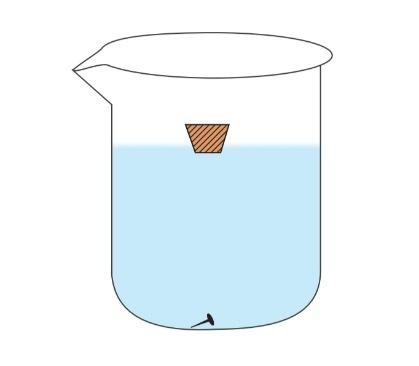Buoyant Force - Definition, Formula, Applications, FAQs
Buoyancy is an important concept in Physics that explains why objects float or sink in liquids and gases. It arises due to the buoyant force an upward force exerted by a fluid on an immersed object because of pressure differences with depth. Learning buoyancy helps explain everyday phenomena such as swimming, floating of ships, and the working of submarines. This topic is a important part of Class 9 and Class 11 Physics and is highly relevant for competitive exams like JEE and NEET. Questions based on buoyant force, Archimedes’ principle and density are frequently asked in both numerical and conceptual forms
This Story also Contains
- What is Buoyancy?
- What is Buoyant Force?
- What is Upthrust Force?
- Si Unit of Buoyant Force
- Buoyant Force Formula
- Relative Density
- What Are the Factors Affecting Buoyant Force?
- Applications of Buoyancy

What is Buoyancy?
When we place an empty plastic bottle on the surface of water, it floats. We all know that gravitational force acts on everything and pulls it downwards. So what is it that keeps the plastic bottle afloat on the surface of water? The water exerts an anti gravitational force on the plastic bottle and hence causing it to float. This phenomenon which causes to float on the surface of water is known as buoyancy.
What is Buoyant Force?
Buoyancy Force Definition: Buoyant force is defined as the upward force exerted by water or any other liquid opposite to the gravity which makes an object to float on the surface of it.
In the above example, the plastic bottle floats as the buoyant force exerted by the water is greater than its weight which is nothing but the gravitational force exerted by the earth. If we want the plastic bottle to be completely immersed into the water, then we need to apply an external downward force which is equal to the gravitational force in order to balance it.
All objects experience a buoyant force when they are immersed fully or partially in a fluid. The magnitude of the buoyant force depends upon the density of the fluid in which the object is immersed.
Also read -
- NCERT Solutions for Class 11 Physics
- NCERT Solutions for Class 12 Physics
- NCERT Solutions for All Subjects
What is Upthrust Force?
The buoyant force is exerted in the upward direction, opposite to the gravitational force hence it is also known as the Upthrust force.
Si Unit of Buoyant Force
As buoyant force is also a type of force, the SI unit of it is Newton (N)
Buoyant Force Formula
The formula for calculating buoyant force is
$
F_b=-\rho g V
$
$F_b=$ buoyant force
$\rho=$ fluid density
$g$ = acceleration due to gravity
$V$ = fluid volume
NCERT Physics Notes :
Why objects float or sink when placed on the surface of water?
Whenever we talk about buoyant force or buoyancy, this question always arises why do some objects float on the surface of the water while some objects sink? When water exerts force on every object placed on the surface of it then why do some objects float and some do not? Let's resolve this query by taking a common example.
If we place an iron nail and a cork on the surface of water and both are of equal masses, we observe that the piece of cork floats on the surface of the water whereas the iron nail sinks even if the masses of both of them are same.

This is because their densities are different. The density of the cork is less than the density of the water which means, the buoyant force exerted by the water on the cork is greater then the weight of the cork which is nothing but gravity hence it floats. Whereas in the case of iron nail, the density of the iron nail is greater than the density of water which means that the buoyant force exerted by the water on the nail is less then its weight hence it sinks.
Therefore, the object placed on the surface of water will float or sinks completely depend on the density of the object as compared to the density of the water.
|
Related Topics, |
Archimedes’ Principle
Archimedes’ Principle is a fundamental law of buoyancy of fluids discovered by a Greek scientist named Archimedes and it is stated as follows:
If we fully or partially immersed a body in a fluid, the upward force experienced by the body is equal to the weight of the fluid displaced by it when it is immersed in the fluid.
This principle explains that when a body is immersed fully or partially in water or in any other liquid, the amount of buoyant force exerted by the liquid and experienced by the object is equal to the fluid displaced by it in weight. Archimede's principle has many applications from designing ships and submarines to determining the density of a liquid.
Relative Density
In order to calculate buoyancy more accurately and also to determine the purity of a substance, the concept of relative density is necessary to understand.
Relative density of any substance is defined as the ratio of density of a substance to the density of water.
Relative density=Density of a substance/Density of water
Since, It is a ratio of same quantities, relative density has no unit.
What Are the Factors Affecting Buoyant Force?
- Density of the fluid – Greater the density of the fluid, greater is the buoyant force.
- Volume of fluid displaced – Buoyant force increases with an increase in the volume of fluid displaced by the object.
- Acceleration due to gravity (g) – Buoyant force is directly proportional to the value of gravitational acceleration.
Applications of Buoyancy
There are several applications of buoyancy. Some of the common natural and human made applications of buoyancy are stated below :
-
Ship ? Did you ever thought why ship float on water even after having such a high weight? This is because the density of ship less as compare to water due to a hollow-like structure. Hence, according to Archimedes principle the buoyant force exerted by water on it is quite high to support the ship and make it float.
-
Submarine ? Submarines are provided with a large ballast tank which gets filled up when the submarine submerge in the water which increases its weight then the buoyant force and when the submarine needs to get out of the water, the tank releases its water to make it lighter then the buoyant force.
-
Fishes ? Fishes have air sacks which they fill in order to increase their weight and move deep inside the water and when they need to move at the surface of water, they empty the air sacks which decreases their weight and the buoyant force automatically move them upward.
Also, check-
Frequently Asked Questions (FAQs)
Density of the fluid – Greater the density of the fluid, greater is the buoyant force.
Volume of fluid displaced – Buoyant force increases with an increase in the volume of fluid displaced by the object.
Acceleration due to gravity (g) – Buoyant force is directly proportional to the value of gravitational acceleration.
A block of plastic released under water come up to the surface of water because the density of block is less then the density of water, which means that the buoyant force exerted by the water is greater than the weight of plastic block hence it come up to the surface.
- Helps ships and boats float on water despite their large mass.
- Used in the working of submarines to sink and rise by controlling buoyant force.
- Enables hot air balloons and airships to rise in air.
- Used in hydrometers and lactometers to measure density of liquids.
- Explains floating of icebergs, cork, and wood on water.
- Applied in design of life jackets and floats to keep people afloat in water.
Given :
Volume of packet = 350 cm3
Weight of the packet = 500 g
Density of water = 1 gcm-3
To find : Density of packet, in order to compare it with density of water and see whether the packet will float or sink
Density of packet = Weight of packetVolume of packet
= 500g350cm3
= 1.428 gcm-3
Therefore, the packet will sink because the density of the packet is greater than the density of water.
Buoyant force is defined as the upward force exerted by a liquid on an object placed on the surface of it. As buoyant force is exerted by water in upward direction it is also known as Upthrust force. It’s SI unit is Newton (N) and it’s formula is given by
Fbuoyant =ρgV
An object will float or sink when placed on the surface of water completely depends on the density of object and density of water. If the density of object is greater than the density of water, it will sink and if the density of object is less than the density of water, it floats.
Given :
Density of object = 10 kgm-3
Density of water = 10-3 kgm-3
To find : Relative density of object
Formula for Relative density ? Relative density =Density of object/Density of water
=10kgm-3/10-3kgm-3
=0.01
Hence, relative density of object is 0.01